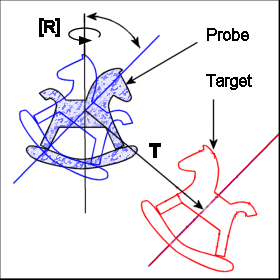Difference between revisions of "Molecular replacement"
From Online Dictionary of Crystallography
(bぁck) |
m (lang) |
||
| Line 1: | Line 1: | ||
| − | <Font color="blue"> Méthode du remplacement moléculaire </Font> (''Fr''). <Font color=""> | + | <Font color="blue">Méthode du remplacement moléculaire</Font> (''Fr''). <Font color="black"> Metodo della sostituzione molecolare</Font> (''It''). <Font color="purple">分子置換法</Font> (''Ja''). |
== Definition == | == Definition == | ||
Revision as of 14:27, 20 March 2015
Méthode du remplacement moléculaire (Fr). Metodo della sostituzione molecolare (It). 分子置換法 (Ja).
Contents
[hide]Definition
An approach to solving the phase problem by concentrating on phase relationships that arise through X-ray diffraction from similar molecular components. The components can be molecular fragments related through noncrystallographic symmetry (e.g. icosahedral subunits of a virus) or a similar molecule such as a homologous protein with high sequence identity.
Discussion
The technique is most commonly used in biological crystallography. Typically, an attempt is made to fit the structure under investigation (the 'target' structure) to a previously solved ('probe') structure. The probe may be a different crystal form of the same protein; or it may be a different protein with a high level of sequence identity, which correlates well with structural resemblance. As a rule of thumb, molecular replacement is often straightforward if the probe is well characterised and shares at least 40% sequence identity with the target.
Figure 1 illustrates schematically the process of repositioning the probe structure (the solid motif) in the new unit cell to coincide with the target structure (red outline motif). Rotation and transformation matrices must be applied. Patterson methods are suitable for determining the rotation function R, since intramolecular vectors are all shifted to the origin of a Patterson map. The orientational fit (i.e. the quality of the calculated rotation function) has usually been assessed by monitoring R factors or real-space correlation coefficients. Increasingly, modern programs use maximum likelihood based algorthms.
The translation function T is then determined to shift the now correctly orientated probe model to the correct coordinates within the asymmetric unit. Space-group symmetries can be used to help reduce the computationally intense calculations required.
History
Early applications of the technique concentrated on large virus structures with icosahedral symmetry. [Rossmann, M. G. & Blow, D. M. (1962). Acta Cryst. 15, 24–31. The detection of sub-units within the crystallographic asymmetric unit.] In the 1960s the early development of the molecular replacement technique was aimed primarily at ab initio phase determination. It was only in the 1970s, when more structures became available, that it was possible to use the technique to solve homologous structures with suitable search models.
See also
- Noncrystallographic symmetry.
- D. M. Blow. International Tables for Crystallography (2006). Vol. F, ch. 13.1, pp. 263-268 doi:10.1107/97809553602060000681
